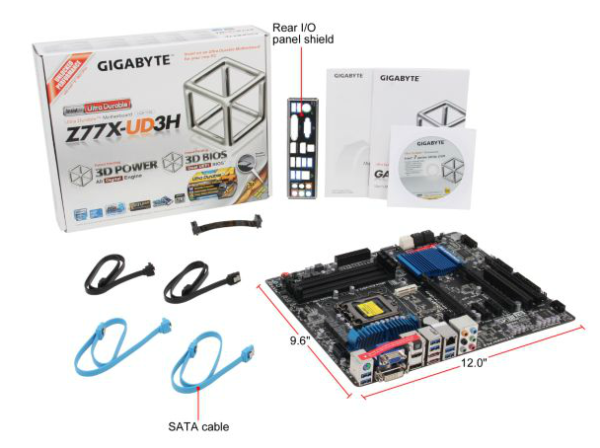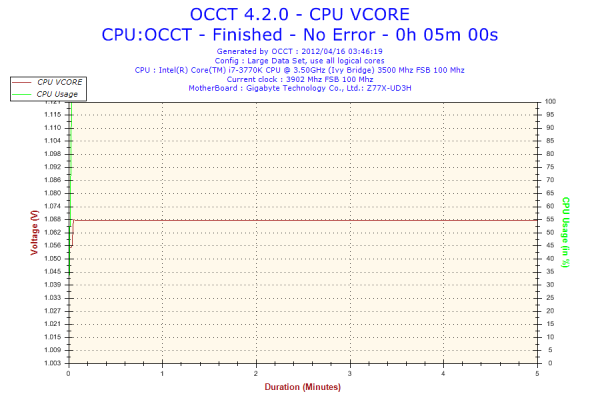Intel Z77 Motherboard Review with Ivy Bridge - ASRock, ASUS, Gigabyte, and MSI
by Ian Cutress on May 7, 2012 7:40 PM EST- Posted in
- Motherboards
- MSI
- Gigabyte
- ASRock
- Asus
- Ivy Bridge
- Z77
Gigabyte GA-Z77X-UD3H - In The Box
Over the past several motherboard generations, I have not been that impressed with Gigabyte's offering in terms of extras - this is because in order to hit a price point, sometimes the extras in the box are not the focus of the product. With the Z77X-UD3H, we are hoping for at least some good stuff here.
Driver CD
User Manual
IO Shield
Four SATA Cables
One long SLI bridge
Voltage Readings
Using OCCT we monitor the voltage change of the motherboard under load. This represents the direct correlation between the Load Line Calibration and how the processor/motherboard deals with voltage requests while under load. This is not to be confused with the quality of power delivery, but more an indication of how aggressive the default LLC settings are on a motherboard.
The response of the Gigabyte board under load is fantastic. No ripple at all and a lower average voltage than the ASUS P8P77-V Pro.
Overclocking
Note: Ivy Bridge does not overclock like Sandy Bridge. For a detailed report on the effect of voltage on Ivy Bridge (and thus temperatures and power draw), please read Undervolting and Overclocking on Ivy Bridge.
The Gigabyte GA-Z77X-UD3H has a variety of overclocking tools at the disposal of the user. Automatic overclocks are through EasyTune6, where we experienced a rather good result with our chip with Gigabyte's auto tuning software, and manual overclocks are either performed through the BIOS (with a series of menu jumps which should have been more carefully laid out), or using a new Gigabyte tool called TweakLauncher. I have not previewed TweakLauncher here, as it is primarily for sub-zero overclockers wanting real-time access to changes in performance while under extreme temperatures. It forgoes the usual GUI interface and sliders with something more amenable to the competitive overclocker - it is not suitable for the majority of users.
Auto Overclock: Using the Auto Tuning option in EasyTune6, the software pulled up a large screen and offered a confirmation of a stress-tested overclock. When clicked yes, the system would stability test a range of BCLK and Multipliers until the board resets or the system finds it unstable. When this had finished, the board offered me a 46x104.5 overclock (4810 MHz). I discovered that turbo modes still applied, so this speed was the single thread speed, and the CPU would reduce the multiplier by two for multithreaded loads, giving 4589 MHz). This gave 1.236 volts at load, which could be a little high, but due to the lower speed under multithreaded load, the CPU only reached 84ºC under PovRay and was completely stable. I enjoyed this result a lot from an automatic overclock!
Manual Overclock: Due to the way Ivy Bridge behaves with increased voltage, for a manual overclock, I am testing the peak overclock at a variety of voltages as well as the temperatures at that voltage. On the Gigabyte board, the CPU load line calibration was set to Extreme and Intel Speed Step was disabled. One interesting thing to note was that Gigabyte set this board to 100.9 MHz default on the BCLK, rather than 100.0 MHz. When the multiplier is pushed above 44x, this is reduced to 100.0 MHz.
At 1.100 volts, the highest multiplier that was stable was 45x, giving 4.5 GHz. This gave 70ºC at load with PovRay, and showed a load voltage of 1.116 volts.
At 1.150 volts, the highest multiplier that was stable was 46x, giving 4.6 GHz. This gave 75ºC at load with PovRay, and showed a load voltage of 1.164 volts.
At 1.200 volts, the highest multiplier that was stable was 47x, giving 4.7 GHz. This gave 82ºC with PovRay, 86ºC with OCCT, and a load voltage of 1.212 volts.
At 1.250 volts, the board successfully booted at 4.8 GHz, with 1.272 volts under load and 89ºC with PovRay - but this was not stable due to the memory errors in PovRay, suggesting more voltage is required. Given the current load temperature, I was unwilling to push the voltage further.
In terms of memory, when attempting to overclock a G.Skill 2x4 DDR3-2666 kit, which performed 2950 MHz on the ASUS P8Z77-V Pro, it would not boot at the DDR3-2800 strap despite all the correct timings being entered.












117 Comments
View All Comments
Paapaa125 - Tuesday, May 8, 2012 - link
Article: "With a lot more controllers to initialise on board, the ASUS P8Z77-V Pro requires at default 20.47 seconds to reach the windows loading screen. By disabling controllers that aren't used, a time more like the ASRock could be achieved."Did you actually test this?
And a suggestion: please test Intel DZ77BH-55K motherboard. It is the only board besides MSI to use the better ACL898 and Intel LAN chip but without other useless bulk (like secondary LAN etc). It seems to have superior BIOS to many others.
IanCutress - Tuesday, May 8, 2012 - link
Hi Paapaa125,I should have an Intel Z77 board inbound to test. I have about 5 others to test as well, and some ITX. Currently reviewing boards in my spare time, so please bear with me as I get through them all! :)
Ian
Paapaa125 - Wednesday, May 9, 2012 - link
Great to hear that! And no need to rush, I can wait :) I hope you test these things:Boot time. Fan control settings. Power consumption. Lan speed/CPU util. Audio quality. And check if the Turbo Boost settings actually are identical. Otherwise the benchmark results are unbiased.
I'm actually more interested in other features than pure computational speed and benchmark scores. The differences are usually insignificant, but the differences in other areas might be big.
althaz - Wednesday, May 9, 2012 - link
Somebody further down the thread posted a message that they configured their Asus 'board to POST much quicker than above.I second request for Intel board reviews! I am particularly interested in the DZ77GA70K as well as the 55K mentioned by Paapaa125. I've been hearing good things about the GA70K but I'm hesitant to commit without finding out about POST times and I'd also like to see if performance is the same between the 55K and 70K.
Shadowmaster625 - Tuesday, May 8, 2012 - link
Can you give us realistic power supply measurements? I am interested in building a fairly fast system that is pretty much always on. So the idle power needs to be as low as possible. I would use a smaller power supply that is at least 85% efficient @ 50 Watts. And no video card. With just one SSD and one optical drive. My best napkin-guess would be an idle power of 40-45 watts.Silenus - Tuesday, May 8, 2012 - link
That's a fair guess for idle. The problem you will have is that ideally you will want a high efficiency supply that at idle is at least 20% loaded. For you 40-45 idle that means you would need a supply probably not more than 200 watts. It is hard to find a 80+ supply at those lower powers. You might consider a small form factor supply. This is just about fits your requirement:http://www.neweggbusiness.com/Product/Product.aspx...
Shadowmaster625 - Tuesday, May 8, 2012 - link
That might be a good choice. I wonder if I would still be able to hit 4.3GHz with that supply. I would definitely keep it at stock volts.haakon_k - Tuesday, May 8, 2012 - link
..or try the 80+ gold alternative from seasonic, if you can find a shop that sells it, 300 or 350W - optionally modular.http://www.seasonic.com/product/pc_tfx.jsp
Unfortunately without any PCIe 6 pin power connector, if you so should get tempted...
Avalon - Tuesday, May 8, 2012 - link
Well that review went as expected. MSI underperformed, Asus was needlessly expensive, Gigabyte had memory issues, and Asrock OC'd with lower voltages. That;s mirrored my experiences in the past few years.goldie.lin - Tuesday, May 8, 2012 - link
Thanks for the nice benchmarks, USB, SATA, LAN, Power Consumption, ...Especially, I appreciate the "DPC Latency" and "Boot Times" tests.
It very useful and practical!!!
Keep working, AnandTech.